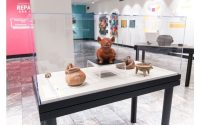Orlando Museum of Art Bequest Controversy, a Taylor Swift Art Experience, Painter Yvette Achkar Dies, and More: Morning Links for May 22, 2024
To receive Morning Links in your inbox every weekday, sign up for our Breakfast with ARTnews newsletter.
THE HEADLINES
STRINGS ATTACHED. The Orlando Museum of Art has asked a Florida court to change spending restrictions on a $1.8 million donation it received from the Margaret Young estate, as it wrangles with a financial crisis, including legal fees related to its fake “Basquiat fiasco,” reports The New York Times. The Young bequest was given on the condition it be used for the museum’s “Permanent Collection Fund and to add to their permanent collection,” states the trust, rather than operating expenses. In its filing, the museum denies it would use the funds to shore up depleted finances and is asking to use the money for “general purposes” in service of its permanent collection. The institution also notes it doesn’t have a specifically titled, “Permanent Collection Fund,” making the donor’s original purpose “impossible.” However, other lawyers have said creating a new fund for the donation was simple, and that the museum has other funds for acquiring art that are simply called something else. Meanwhile, other museum donors have expressed concerns their gifts could be used for operating costs, which critics say a modification to the Young bequest could facilitate.
SWIFTIE ART TRAIL. A moss-covered piano sculpture, a mural, tie-dye and other craft workshops, are just some of the featured art installations being set up along the forthcoming “Taylor Town” exhibit that will run through Liverpool to celebrate Taylor Swift’s three sold-out June concerts in the city, reports the BBC. Swift fans (aka Swifties) will be able to wander through 11 installations in venues around town, each representing a Swift album, as part of an initiative organized by Liverpool Council’s culture team and social enterprise Make CIC. Featuring “incredible art” was the “right thing to do,” for the mega-star’s arrival, said Claire McColgan, Liverpool’s Director of Culture. As for the participating artists, some of those who were selected said they’ve all but joined the Swiftie global phenomenon since working on their projects. “I’m definitely a super Swiftie now. I wouldn’t say I was one before,” said featured artist Rachel Smith-Evans.
THE DIGEST
Abstract painter Yvette Achkar passed away on May 12, age 96. Born in Brazil to Lebanese parents in 1928, she was recently included in the traveling exhibit “Taking Shape: abstraction from the Arabe World, 1950-1980,” of works from the Barjeel Art Foundation in Sharjah. [ArtAsiaPacific]
Alex Fortescue, managing partner of the equity firm Epiris, which owns Bonhams auction house, has died at age 55, following a reported “incident while cycling.” [The Art Newspaper]
About 100 workers in Argentina’s film industry are demonstrating at the Cannes Film Festival in France against “chainsaw” budget cuts to the country’s culture sector, under far-right President Javier Milei. “The current government has embarked on a crusade against culture, science and education,” Argentinian film producer Clara Massot told reporters. [France 24]
Pixar animation studios is firing 14 percent of its staff, or 175 people, announced Pixar president Jim Morris in an internal memo seen by The New York Times. The studio will also stop making original shows for Disney+ and will “return to our focus on feature films.” [The New York Times]
A painting by Alfred Sisley and another by Auguste Renoir were restituted to 11 legal heirs of the Jewish galleries Grégoire Schusterman in a ceremony in France last week. Their sale in 1941 was forced by Nazi occupiers in France, and the paintings were among thousands of “orphan,” or ownerless artworks brought back to France from Germany after WWII. [Le Monde]
The Town of Vail in Colorado said they would rescind their Art in Public Places (AIPP) residency offer for Native artist Daniel See Walker due to her art piece, G is for Genocide (2024). “AIPP’s mission is to create a diverse and meaningful public art experience in Vail, but to not use public funds to support any position on a polarizing geopolitical issue,” stated the AIPP. [Hyperallergic]
The Basel Social Club art fair, with some 60 participating galleries, will hold its upcoming edition from June 9 to 16 outdoors, on 72 hectares of farmland about 10km south of the main Art Basel event. “This year we are telling people to come to come to the fields, drink a beer and enjoy art within nature,” said Robbie Fitzpatrick, co-founder of the fair. [Financial Times]
The artists William Powhida and Jennifer Dalton have founded a new Zero Art Fair in Elizaville, upstate New York. They designed the fair for artists who want to clear out storage spaces by giving away artworks under specific, contracted terms, where ownership of the work is transferred after five years if it hasn’t sold, during which time it remains sellable by the artist. Plus, after ownership is transferred, the artist is entitled to 50 percent of sale profits. [Artnet News]
THE KICKER
RESTORING LAS MENINAS. It’s been 40 years since the saga over the controversial cleaning and restoration of Diego Valázquez’s 1656 masterpiece, Las Meninas by a non-Spaniard.Now, El Pais is recalling the tale. Reporter Ana Marcos spoke to another restorer at the Prado Museum, where the painting is housed, who witnessed it all, and had a hand in its final touches. The British specialist, John Brealy, who worked at the Metropolitan Museum in New York, was chosen for the job in 1984, but the fact that he was not Spanish led to a national debate. At one point, at the sounds of screams from an angry professor and his students who demanded the restoration stop, Brealy even fled the Prado in fear for his life. “The expert got scared, he thought they were coming to lynch him, he stopped his work for the day and left,” writes Marcos. “I was condemned in advance. Before they knew what I was going to do,” recalled Brealy in a past interview with El Pais. But his methods ended up setting a precedent for restoration at the museum, and despite the pressures of a nation and the heavy workload itself, Brealy offered his services free of charge.



